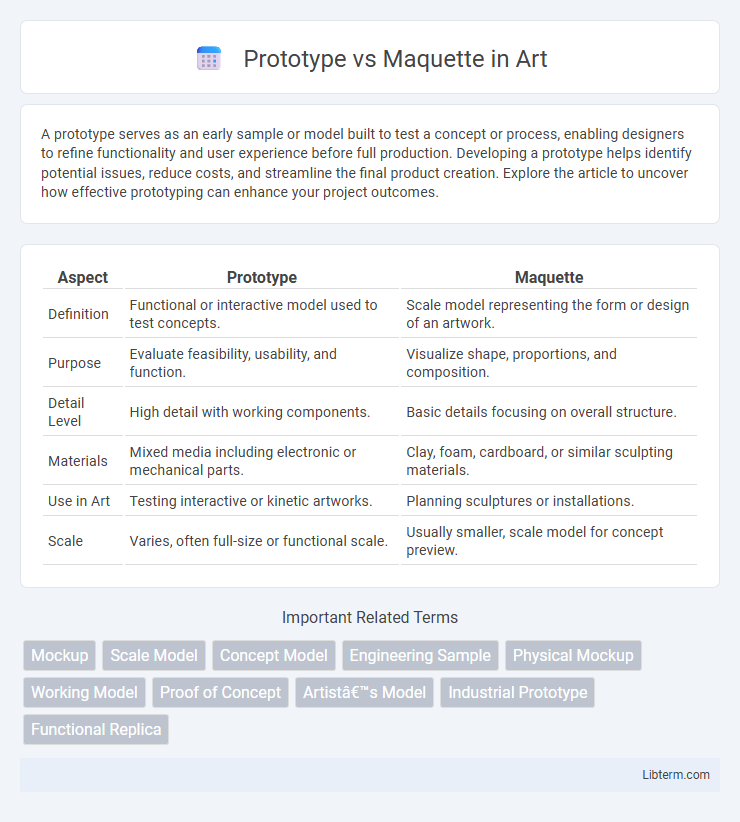A prototype serves as an early sample or model built to test a concept or process, enabling designers to refine functionality and user experience before full production. Developing a prototype helps identify potential issues, reduce costs, and streamline the final product creation. Explore the article to uncover how effective prototyping can enhance your project outcomes.
Table of Comparison
| Aspect | Prototype | Maquette |
|---|---|---|
| Definition | Functional or interactive model used to test concepts. | Scale model representing the form or design of an artwork. |
| Purpose | Evaluate feasibility, usability, and function. | Visualize shape, proportions, and composition. |
| Detail Level | High detail with working components. | Basic details focusing on overall structure. |
| Materials | Mixed media including electronic or mechanical parts. | Clay, foam, cardboard, or similar sculpting materials. |
| Use in Art | Testing interactive or kinetic artworks. | Planning sculptures or installations. |
| Scale | Varies, often full-size or functional scale. | Usually smaller, scale model for concept preview. |
Prototype vs Maquette: Understanding the Basics
Prototypes and maquettes serve distinct roles in the design process, with prototypes focusing on functionality and user interaction, while maquettes emphasize visual form and spatial relationships. Prototypes are typically interactive models used to test usability and refine features before final production, often incorporating materials that mimic the end product. Maquettes are scale models or rough drafts primarily used in art, sculpture, and architecture to explore shapes and proportions without functional elements.
Defining Prototypes in Design and Development
Prototypes in design and development serve as functional representations of a product, enabling testing and refinement of concepts through interactive features and realistic user experiences. Unlike maquettes, which are primarily static scale models focused on visual form and spatial relationships, prototypes emphasize usability, functionality, and iterative feedback. This approach accelerates innovation by validating design hypotheses before full-scale production, reducing costly revisions.
What is a Maquette? An Artistic Perspective
A maquette is a small-scale, three-dimensional model used by artists to visualize and refine the composition, form, and spatial relationships of a sculpture or artwork before creating the full-sized piece. It serves as a tactile, tangible blueprint that helps sculptors explore proportions, textures, and details, allowing iterative adjustments in the creative process. Unlike prototypes, which often emphasize functional testing and engineering aspects, maquettes prioritize artistic expression and aesthetic development during early design stages.
Key Differences Between Prototypes and Maquettes
Prototypes are functional models designed to test and refine usability, mechanics, or user experience, often incorporating moving parts or interactive elements, whereas maquettes are static, scale models primarily used to visualize and communicate design concepts in three-dimensional form. Prototypes emphasize performance evaluation and iteration in product development, while maquettes focus on aesthetics, form, and spatial relationships for artistic or architectural presentations. The key difference lies in prototyping's role in practical testing versus maquettes' use for conceptual visualization.
Purposes of Prototypes in Product Development
Prototypes serve as functional models in product development to test design concepts, user interactions, and technical feasibility before full-scale production. They help identify potential flaws, gather user feedback, and refine features, thereby reducing development costs and time. Unlike maquettes, which are primarily visual or scale models for design presentation, prototypes emphasize usability and performance evaluation.
The Role of Maquettes in Artistic Creation
Maquettes serve as essential three-dimensional preliminary models in artistic creation, allowing artists to experiment with form, scale, and composition before finalizing their work. These small-scale representations provide tangible insights into spatial relationships and structural balance, facilitating critical adjustments early in the creative process. Unlike prototypes, which often focus on functionality and user interaction, maquettes center on visual exploration and artistic expression.
Materials and Methods: Prototypes vs Maquettes
Prototypes are typically constructed using durable materials such as plastic, metal, or wood, employing methods like 3D printing, CNC machining, or hand assembly to create functional and testable models. Maquettes, on the other hand, are often made from lightweight and easily manipulated materials like clay, foam, or cardboard, using sculpting, carving, or simple assembly techniques to visualize form and scale. The choice of materials and methods reflects prototypes' focus on function and precision, whereas maquettes prioritize rapid conceptual development and spatial representation.
When to Use a Prototype vs a Maquette
Use a prototype when testing functionality, user interaction, and design feasibility to gather actionable feedback and identify potential issues early in the development process. Opt for a maquette when visualizing form, scale, and spatial relationships, primarily for aesthetic evaluation and stakeholder presentations before detailed functionality is introduced. Choosing a prototype aids iterative refinement through hands-on trials, while a maquette supports conceptual approval through physical or digital models emphasizing appearance.
Advantages and Limitations of Prototypes and Maquettes
Prototypes offer interactive and functional representations that allow for user testing and early detection of design flaws, accelerating development and improving final product quality. However, they can be time-consuming and costly to produce, especially when high-fidelity fidelity is required, potentially limiting rapid iteration. Maquettes provide quick, tangible three-dimensional models that facilitate spatial visualization and communication of design concepts, though they lack functional capabilities and detailed accuracy, restricting their use for performance evaluation.
Choosing the Right Model for Your Project
Selecting the right model between a prototype and a maquette depends on the project's goals and stage of development. Prototypes are functional representations used to test design feasibility, usability, and performance, making them ideal for product development and engineering. Maquettes serve as scaled, three-dimensional visual models primarily for aesthetic evaluation, commonly utilized in architecture, sculpture, and design presentations.
Prototype Infographic

 libterm.com
libterm.com